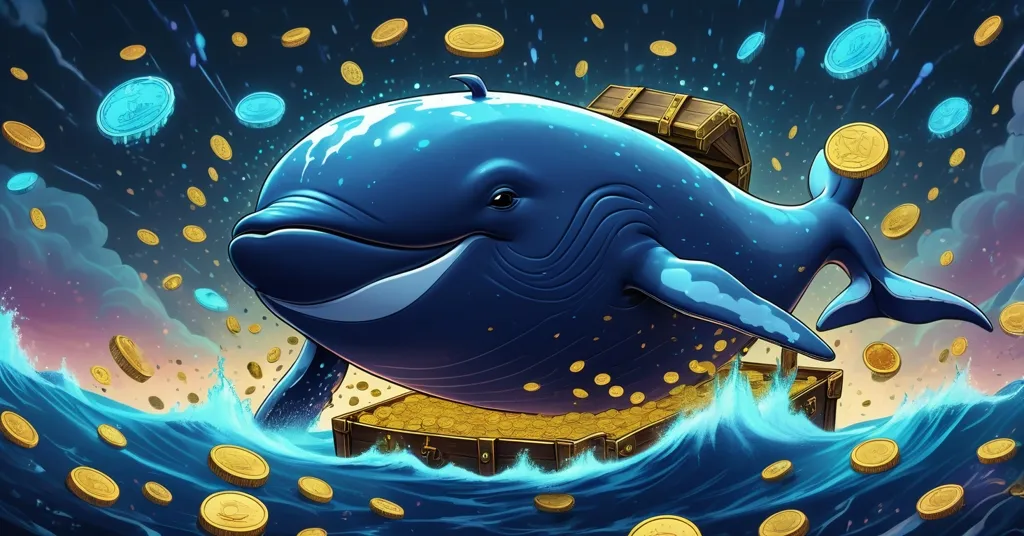Cardano (ADA) Price Prediction 2024: Whale Buying and Airdrop Hype Fuel Rally Hopes

Cardano (ADA) Price Prediction 2024: Can Whale Buying and Airdrop Hype Spark a Rally?
Cardano (ADA) is back in the spotlight, with large investors piling in, a much-talked-about airdrop on the horizon, and network activity hitting new highs. Trading at roughly $0.58, could this altcoin be gearing up for a short-term jump to $1.41—or are we just riding another wave of crypto hype with a long-shot dream of $60 by 2035?
- Whale Moves: Institutional players are stacking ADA, hinting at strong confidence in its future.
- Airdrop Excitement: The Midnight Token Distribution (Glazer Airdrop) promises free tokens to ADA holders, stirring market buzz.
- Network Surge: Cardano has processed over 111 million transactions, showcasing growing usage.
Let’s break down what’s driving Cardano’s momentum and whether this altcoin has the legs for a real rally. With Bitcoin smashing past $108,000 and the total crypto market cap ballooning to $3.35 trillion, the stage is set for altcoins like ADA to catch fire. A recent 3.47% price uptick over the past week, bouncing from $0.565 to $0.58, has analysts and investors eyeing bigger gains. But between whale accumulation, an upcoming token giveaway, and solid on-chain stats, is Cardano’s rise built on fundamentals, or are we just seeing another speculative fever dream? Let’s unpack the catalysts, the challenges, and the cold, hard reality of where Cardano’s blockchain technology stands in the blockchain race.
Whale Accumulation: Smart Money or Market Hype?
One of the biggest signals for Cardano right now is the heavy buying from whales—those large investors with deep pockets who often move markets. On-chain data suggests ADA is among the most accumulated altcoins by institutional players this year, with platforms like Santiment reporting spikes in wallets holding over 1 million tokens. This isn’t blind gambling; whale buying often hints at insider belief in a project’s long-term value. For retail investors, it’s a validating sign that smart money is betting on Cardano, potentially pushing prices through key levels. Analysts are pointing to short-term targets between $0.67 and $1.40, with resistance points at $0.90 and beyond if momentum holds. As a voice from the YouTube channel Cheeky Crypto noted:
ADA reaching $1.41 is within reach based on recent price structure and momentum.
But let’s not get too starry-eyed. Whale activity can cut both ways—sometimes it’s a precursor to a rally, other times it’s just market manipulation before a dump. Retail investors should tread carefully, as following the big fish doesn’t guarantee profits in a market as volatile as crypto. Plus, without granular data on exact volumes or timelines of these purchases, it’s hard to gauge how much impact this whale buying trend will truly have.
Midnight Airdrop: Reward or Risky Distraction?
Adding fuel to the Cardano fire is the upcoming Midnight Token Distribution, also called the Glazer Airdrop. This event will reportedly hand out new tokens—dubbed Night and Dust—to ADA holders, though participants must manually claim them to join in. Airdrops are a tried-and-true tactic in crypto to drum up interest and engagement, often triggering short-term price spikes as investors rush to qualify by holding or buying more of the base token. Comments from Cardano co-founder Charles Hoskinson have sparked speculation about the potential value of these tokens, though nothing is set in stone.
Before you get too excited, a word of caution: airdrops are a breeding ground for scammers. Fake claim sites and phishing schemes are already circling like vultures, waiting to drain wallets of unsuspecting holders. Stick to official sources like cardano.org or announcements from Input Output Global to verify details—don’t risk your funds on unverified hype. For more clarity on claiming the Midnight Airdrop for ADA holders, ensure you’re following trusted channels. Even beyond scams, airdrops can lead to token dilution, where an influx of new supply reduces the value of existing ADA, much like slicing a pie into smaller pieces. So while this event might spark interest, it’s not a guaranteed win for price action—sometimes the buzz fizzles into a sell-off once the freebies are claimed.
Network Growth: Numbers That Can’t Be Ignored
Beneath the surface hype, Cardano’s blockchain is showing real signs of life. The network has surpassed 111 million transactions, a clear marker of growing usage and developer interest. For those new to the space, Cardano is a Proof-of-Stake (PoS) blockchain, launched in 2017, that uses a unique consensus mechanism called Ouroboros to ensure secure transactions with low energy use—making it cheaper and greener than Bitcoin’s mining-heavy system. Its methodical, academic approach, rooted in peer-reviewed research, sets it apart from flashier rivals. Currently in the Basho era, focused on network optimization, Cardano is prepping for the Voltaire era, which will roll out governance features like on-chain voting and treasury management.
These upgrades could be pivotal for Cardano’s appeal in decentralized finance (DeFi) and beyond, aligning with our ethos of decentralization and user empowerment. If Voltaire delivers, Cardano could become a true democracy of code—something even Bitcoin, with its laser focus on being digital gold, doesn’t aim to achieve. But while the transaction numbers are impressive, adoption in practical applications like DeFi tells a more sobering story, which we’ll get to next. For the latest on ADA’s market trends and data, keep an eye on trusted platforms.
Cardano’s DeFi Struggles: A Long Road Ahead
Let’s talk about where Cardano stands in the DeFi arena, a critical piece of any blockchain’s value proposition. Total Value Locked (TVL)—the amount of money invested in a blockchain’s DeFi apps, reflecting its popularity for financial services—sits at a modest $251 million for Cardano. Compare that to Solana, which boasts a staggering $8.6 billion in TVL, or Ethereum’s multi-hundred-billion-dollar ecosystem, and the gap is glaring. Cardano also hosts just $31 million in on-chain stablecoins, a tiny fraction compared to competitors. Solana’s bustling ecosystem, with over 450,000 daily active users, a thriving NFT market, and partnerships like Chainlink, makes Cardano’s DeFi footprint look more like a quiet suburb than a financial hub.
That said, there’s potential for growth. Projects like SundaeSwap and Minswap are early players in Cardano’s DeFi space, and if upcoming upgrades improve scalability and interoperability, more developers might flock to the platform. Lower transaction fees compared to Ethereum could be a draw, assuming execution sticks. But for now, Cardano is playing catch-up, and anyone banking on a quick moonshot needs to grapple with the challenges facing Cardano’s DeFi ecosystem. Dominating DeFi isn’t just a nice-to-have for altcoins—it’s often the make-or-break for long-term relevance.
Price Predictions: Grounded Goals or Sci-Fi Fantasy?
Now for the part everyone’s buzzing about: how high can ADA climb? Short-term forecasts suggest a push to $1.41 if bullish momentum holds, with key resistance levels between $0.90 and $1.40. These targets seem plausible given recent price action, whale buying, and market-wide optimism with Bitcoin leading the charge. But then there’s the wilder speculation—some voices are tossing out a $60 price tag for ADA by 2035. Let that sink in. With a circulating supply of roughly 36 billion tokens, that implies a market cap over $2 trillion, when the entire crypto market today is $3.35 trillion. As Cheeky Crypto’s host argued:
Dismissing a $60 ADA price due to market cap limitations misses the point.
I’m not buying it. A $60 ADA isn’t a forecast; it’s a sci-fi script. Sure, Cardano’s historical swings—from a $0.02 launch to a $1.31 peak in 2017—prove it can make wild runs, especially in bull markets tied to Bitcoin halving cycles. And if it captures a massive slice of the DeFi pie while broader conditions like Federal Reserve money-printing juice altcoin gains, who knows? For a deeper dive into ADA price predictions for 2024, check out detailed analyses. But the road to that kind of dominance is littered with obstacles—slow adoption, fierce competition from Solana and Ethereum, and regulatory landmines like SEC crackdowns that have crushed altcoins before. Turning a $10,000 investment into $1 million sounds like a crypto fairy tale, and anyone peddling it as a sure thing is likely shoveling pure hopium nonsense.
Why Cardano Matters Beyond the Price Tag
Let’s step back from price obsession for a moment. Cardano isn’t just another altcoin chasing hype; it’s a project with a unique vision. Its academic rigor—think peer-reviewed papers over Twitter shilling—offers a slow-and-steady counterpoint to the chaos of crypto. The focus on governance through the Voltaire era could empower users in ways centralized finance can’t touch, accelerating the downfall of bloated banking dinosaurs, a goal worth rooting for in line with effective accelerationism. Unlike Bitcoin’s singular mission as digital gold, Cardano’s sprawling ambitions in DeFi and user-led systems carry higher risks but also niche potential to disrupt traditional finance.
Yet, ambition isn’t adoption. Cardano must execute flawlessly to stand out in a crowded field. Solana’s speed (65,000 transactions per second) and Ethereum’s entrenched developer base aren’t slowing down, and past network outages on rival chains show how fragile trust can be. For insights into how Solana’s DeFi growth compares to Cardano, the disparity is evident. Cardano’s methodical pace might build a lasting foundation, but in crypto, being late to the party often means missing the dance altogether.
Bitcoin’s Shadow and Broader Risks
As much as Cardano has its own story, it can’t escape Bitcoin’s gravitational pull. Altcoins often rally when BTC surges, as we’re seeing now with Bitcoin over $108,000. But they can crash just as hard if Bitcoin stumbles or if regulatory hammers drop. Remember the 2021 China mining ban? It didn’t just hit BTC—it dragged altcoins into the mud too. Cardano, like most altcoins, faces scrutiny from bodies like the SEC, especially as DeFi and token distributions draw more attention. Add in macroeconomic wildcards—interest rate hikes or shifts in Fed policy—and the bullish case for ADA gets murkier. Whales might believe in Cardano, but they can’t shield it from systemic shocks. Curious about how high ADA could go with whale activity? The speculation continues to grow.
Key Takeaways and Questions for Cardano’s Future
- What’s behind Cardano’s potential price rally?
Key drivers include whale accumulation by large investors, the Midnight Token Distribution airdrop, and robust network activity with over 111 million transactions processed. - What exactly is the Midnight Token Distribution (Glazer Airdrop)?
It’s an event offering new tokens like Night and Dust to ADA holders who manually claim them, aimed at boosting ecosystem interest, though official confirmation of details is crucial. - Is a short-term jump to $1.41 realistic for ADA?
Analysts see it as possible based on technical patterns and resistance levels up to $1.40, but crypto’s volatility means no guarantees exist. - Could ADA really hit $60 by 2035?
This speculative target hinges on Cardano dominating DeFi, a long shot given its current $251 million TVL against Solana’s $8.6 billion—treat it as a distant dream for now. - How does Cardano compare to Solana in DeFi adoption?
Cardano lags significantly, with a TVL of $251 million versus Solana’s $8.6 billion, though upgrades could narrow the gap if adoption grows. - What are the risks of chasing airdrop hype?
Scams and token dilution are major concerns—verify all details through official channels to avoid losing funds to fake claim sites. - Should retail investors trust whale accumulation trends?
Whale buying can signal confidence and drive momentum, but it’s not foolproof; weigh it against market risks and do thorough research before investing. - Why does Cardano matter beyond price speculation?
Its academic approach and governance focus could disrupt traditional finance, filling niches Bitcoin doesn’t target, provided execution matches ambition.
Cardano’s story is still unfolding, but in crypto, blind faith is a losing bet. The whale buying, airdrop buzz, and network growth paint a hopeful picture, yet DeFi struggles, fierce competition, and regulatory shadows loom large. Dig deeper, question everything, and watch the market like a hawk. ADA might have a ticket to ride, but nobody can predict how high or how fast it’ll climb.



